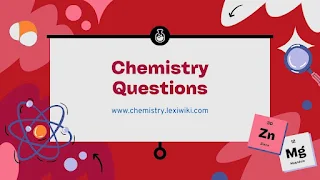Questions on Amines (Organic Chemistry)
20 multiple-choice questions with five alternatives (A–E) on Amines (Organic Chemistry). The correct answers and extended explanations are provided at the end.
-- Ads --
Multiple Choice Questions: Amines (Organic Chemistry)
1. What is the general formula of a primary amine?
A) R–NH–R'
B) R–NH₂
C) R–N⁺H₃
D) R–CH₂NH₂
E) R–COOH
2. Which of the following functional groups characterizes amines?
A) –OH
B) –CHO
C) –COOH
D) –NH₂
E) –CO–
3. What is the IUPAC name of CH₃NH₂?
A) Methanamine
B) Methylamine
C) Aminomethane
D) Ammonia
E) Methanoic acid
4. Amines are derivatives of which inorganic compound?
A) Water
B) Ammonia
C) Hydrochloric acid
D) Methane
E) Carbon dioxide
5. Which of the following is a secondary amine?
A) CH₃NH₂
B) (CH₃)₂NH
C) CH₃CH₂CH₂NH₂
D) NH₃
E) CH₃CH₂NHCH₂CH₃
6. Which of the following is true about tertiary amines?
A) They have one alkyl group attached to nitrogen
B) They have two hydrogen atoms on nitrogen
C) They cannot form hydrogen bonds with water
D) They have three alkyl or aryl groups attached to nitrogen
E) They contain a carbonyl group
7. Amines are classified based on:
A) The number of nitrogen atoms
B) The number of carbon atoms
C) The number of hydrogen atoms attached to nitrogen
D) The pH of the solution
E) Their boiling points
8. What type of amine is CH₃CH₂NHCH₃?
A) Primary
B) Secondary
C) Tertiary
D) Quaternary
E) Amide
9. What is the basicity of amines due to?
A) Oxygen lone pair
B) The lone pair of electrons on nitrogen
C) π-bond delocalization
D) Hydrogen bonding
E) Resonance with carbonyl group
10. Which of the following is a typical reaction involving amines?
A) Esterification
B) Dehydration
C) Acid-base reaction
D) Combustion
E) Saponification
11. What happens when an amine reacts with hydrochloric acid?
A) Forms an ester
B) Forms an amide
C) Forms a salt
D) Forms a ketone
E) Forms a hydrocarbon
12. What is the general trend of boiling points among primary, secondary, and tertiary amines?
A) Tertiary > Secondary > Primary
B) Primary > Secondary > Tertiary
C) All have the same boiling point
D) Depends only on molecular weight
E) Tertiary > Primary > Secondary
13. Which of the following compounds contains an aromatic amine?
A) CH₃NH₂
B) CH₃CH₂NHCH₃
C) C₆H₅NH₂
D) (CH₃)₃N
E) NH₃
14. Which naming suffix is used for amines in IUPAC nomenclature?
A) –oic acid
B) –ol
C) –al
D) –amine
E) –one
15. What is the hybridization of nitrogen in a simple amine?
A) sp
B) sp²
C) sp³
D) dsp²
E) sp²d
16. Amines can act as:
A) Only acids
B) Neither acids nor bases
C) Only oxidizing agents
D) Weak bases
E) Strong acids
17. What happens when an amine reacts with an acyl chloride?
A) Alcohol is formed
B) Amide is formed
C) Ester is formed
D) Hydrocarbon is formed
E) Nitrile is formed
18. What is the solubility trend of lower aliphatic amines in water?
A) Insoluble
B) Slightly soluble
C) Soluble due to hydrogen bonding
D) Soluble only in acids
E) Soluble only in alcohol
19. Which of the following describes aniline?
A) Aromatic aldehyde
B) Aromatic amide
C) Aromatic ketone
D) Aromatic amine
E) Aliphatic amine
20. Which physical property decreases from primary to tertiary amines?
A) Volatility
B) Solubility in water
C) Molecular weight
D) Reactivity
E) Nitrogen content
- Questions on Aldehydes and Ketones (Organic Chemistry)
- Questions about Carboxylic Acids (Organic Chemistry)
- Questions about Esters (Organic Chemistry)
✅ Answer Key with Extended Explanations
1. B – A primary amine has one alkyl or aryl group and two hydrogen atoms on nitrogen: R–NH₂.
2. D – Amines contain the –NH₂ group (primary), or substituted variants.
3. A – CH₃NH₂ is methanamine in IUPAC, also called methylamine (common name).
4. B – Amines are derived from ammonia (NH₃) by replacing hydrogen atoms with alkyl or aryl groups.
5. B – (CH₃)₂NH is a secondary amine, with two alkyl groups on nitrogen.
6. D – Tertiary amines have three carbon-containing groups bonded to the nitrogen.
7. C – Amines are classified by the number of hydrogen atoms replaced on nitrogen.
8. B – CH₃CH₂NHCH₃ is a secondary amine (ethylmethylamine).
9. B – The basicity comes from the lone pair of electrons on nitrogen, which can accept a proton.
10. C – Amines react with acids in acid-base neutralization reactions.
11. C – Amines react with HCl to form ammonium salts.
12. B – Primary amines form more hydrogen bonds, giving them higher boiling points than tertiary.
13. C – C₆H₅NH₂ (aniline) is an aromatic amine.
14. D – The suffix for amines in IUPAC naming is –amine.
15. C – Nitrogen in amines is sp³ hybridized.
16. D – Amines are weak bases, due to the lone pair on nitrogen.
17. B – Amine + acyl chloride → amide.
18. C – Lower aliphatic amines are soluble in water due to hydrogen bonding.
19. D – Aniline is an aromatic amine (phenylamine).
20. B – Hydrogen bonding decreases from primary to tertiary amines, reducing solubility in water.
Dive into the groundbreaking science of neurotransmitters—your brain’s invisible architects—in Chemical Harmony: How Neurotransmitters Shape Our Lives (2025). This meticulously researched book reveals how serotonin, dopamine, GABA, and other brain chemicals silently orchestrate every aspect of your existence, from decision-making and relationships to mental health and emotional resilience.Click here to buy
Share Online!

